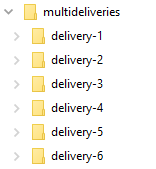Deploying Multiple Deliveries as one delivery¶
When several single deliveries are to be installed, the normal way is to install them one by one in the same order as the deliveries was built.
If many single deliveries should be installed at the same time the script create-multi-delivery Installer scripts overviewInstaller supports merging of the created single deliveries to one. This will reduce downtime of the system.
Prerequisites¶
Important: The included deliveries must have been built in an uninterrupted sequence and the delivery folder copied with unique names to a location, e.g. c:\multideliveries
Example:


Merging the delivery¶
Merging deliveries means that the files in each single delivery will be copied to a new location, in defined order, overwriting existing previously copied files.
The database part of a delivery can be done it two different ways, merging the database code into one install.tem or installing each install.tem from the single deliveries in sequence. If the single deliveries contain different types of install.tem (advance/noadvance) then the database code cannot be merged. A delivery containing a master install.tem (see No merge of database files below), created by an earlier merge process of deliveries, cannot be included in an another merge.
When the merging has been completed, a file named Merged_Deliveries.log has been created in the new location. It contains information about the included single deliveries, listed in the defined order.
Merging database files
The database sub folders will be copied in sequence and the files calling these single files in the subfolders will be regenerated, as well as the tem files (e.g. install.tem) and install.ini file. Also the database installation scripts will be regenerated which will lead to different installation order than when installing deliveries in sequence.
No merge of database files
The database folder in each single delivery will be copied to database folder as a subfolder, named as the single delivery and a new install.tem (master install.tem) will be created, calling these single deliveries install.tem in the defined copy order.
If a _utils folder is included in any of the single deliveries, the folder will be copied to the top database folder as well as the define.tem from the single delivery. If multiple versions of _utils exist in the single deliveries, they will be copied on top of each other as well as the define.tem
If any additional.tem files exist in the sub folders (e.g. ial.tem or eventaction.tem), a master tem for each of them will be created.
Running the script¶
The script will be found in ifsinstaller/utils folder and it's documentation will be found here.